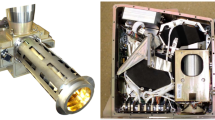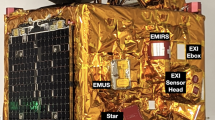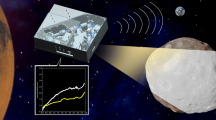Abstract
New planned orbiter missions to Mercury have prompted renewed efforts to investigate the surface of Mercury via ground-based remote sensing. While the highest resolution instrumentation optical telescopes (e.g., HST) cannot be used at angular distances close to the Sun, advanced ground-based astronomical techniques and modern analytical and software can be used to obtain the resolved images of the poorly known or unknown part of Mercury. Our observations of the planet presented here were carried out in many observatories at morning and evening elongation of the planet. Stacking the acquired images of the hemisphere of Mercury, which was not observed by the Mariner 10 mission (1974–1975), is presented. Huge features found there change radically the existing hypothesis that the “continental” character of a surface may be attributed to the whole planet. We present the observational method, the data analysis approach, the resulting images and obtained properties of the Mercury’s surface.
Similar content being viewed by others
References
M.H. Acuna, J.E.P. Connerney, N.F. Ness, R.P. Lin, D. Mitchell, C.W. Carlson, J. McFadden, K.A. Anderson, H. Reme, C. Mazelle, D. Vignes, P. Wasilewski, P. Cloutier, Global distribution of crustal magnetization discovered by the Mars global surveyor MAG/ER experiment. Science 284(5415), 790 (1999)
L.A. Akimov, On the brightness distribution across the lunar disk and planets. Astron. Zh. 56, 412–418 (1979) (in Russian)
L.A. Akimov, Reflection of light by the Moon I. Kinematika Fiz. Nebesnikh Tel. 4(1), 3–10 (1988) (in Russian)
L.A. Akimov, Y.V. Kornienko, Light scattering by the lunar surface. Kinematika Fiz. Nebesnikh Tel. 10(2), 15–22 (1994) (in Russian)
N. Artemieva, L. Hood, B.A. Ivanov, Impact demagnetization of the Martian crust: Primaries versus secondaries. Geophys. Res. Lett. 32(22) (2005). doi:10.1029/2005GL024385
A. Balogh, G. Giampieri, The origin of Mercury’s magnetic field and its multipolar structure. EGS XXVII General Assembly, Nice, 21–26 April 2002, abstract #5959
J. Baumgardner, M. Mendillo, J.K. Wilson, Digital high-definition imaging system for spectral studies of extended planetary atmospheres. 1. Initial results in white light showing features on the hemisphere of Mercury unimaged by Mariner 10. Astron. J. 119, 2458–2464 (2000)
W. Benz, Space Sci. Rev. (2007, this issue)
W. Benz, W.L. Slattery, A.G.W. Cameron, Collisional stripping of Mercury’s mantle. Icarus 74, 516–528 (1988)
B.J. Buratti, J. Veverka, Voyager photometry of Europa. Icarus 55, 93–110 (1983)
B.J. Butler, D.O. Muhleman, M.A. Slade, Mercury – Full-disk radar images and the detection and stability of ice at the North Pole. J. Geophys. Res. 98, 15003–15023 (1993)
S. Chandrasekhar, Radiative Transfer (Dover, New York, 1960)
S.C. Chase, E.D. Miner, D. Morrison et al., Preliminary infrared radiometry of the night side of Mercury from Mariner 10. Science 185, 142–145 (1974)
J.E.P. Connerney, N.F. Ness, Mercury’s magnetic field and interior, in Mercury (University of Arizona Press, Tucson, 1988), pp. 494–513
J.E.P. Connerney, M.H. Acuña, P.J. Wasilewski, G. Kletetschka, N.F. Ness, H. Rème, R.P. Lin, D.L. Mitchell, The global magnetic field of Mars and implications for crustal evolution. Geophys. Res. Lett. 28(21), 4015–4018 (2001). doi:10.1029/2001GL013619
J.E.P. Connerney, M.H. Acuña, N.F. Ness, T. Spohn, G. Schubert, Mars crustal magnetism. Space Sci. Rev. 111(1), 1–32 (2004a)
J.E.P. Connerney, M.H. Acuna, N.F. Ness, D.L. Mitchell, R.P. Lin, H. Reme, A magnetic perspective on the Martian crustal dichotomy. Hemispheres Apart: the Origin and Modification of the Martian Crustal Dichotomy. LPI Contribution No. 1213. Proceedings of the conference held September 30–October 1, 2004, in Houston, TX, USA, 2004b, pp. 11–12
A.C. Cook, M.S. Robinson, Mariner 10 stereo image coverage of Mercury. J. Geophys. Res. 105(E4), 9429–9443 (2000)
A. Danjon, Photometrie et colorimetrie des planetes Mercure et Venus. Bull. Astron. 14, 315 (1949)
R.F. Dantowitz, S.W. Teare, M.J. Kozubal, Ground based-based high-resolution imaging of Mercury. Astron. J. 119, 2455–2457 (2000)
M.E. Davies, S.E. Dwornik, D.E. Gault, R.G. Strom, Atlas of Mercury, in NASA Scientific and Technical Report, ed. by J. Dunn, NASA SP-42 (US Government Printing Office, Washington, 1978)
A.Z. Dolginov, Magnetic fields and nonuniform structures of the Moon. Twenty-fourth Lunar and Planetary Science Conference. Part 1: A-F, 1993, pp. 411–412
A. Dollfus, Pic-du-Midi visual and photographic observations of planets, in Planets and Satellites, ed. by G.P. Kuiper, B.M. Middlehurst (The University of Chicago Press, Chicago, 1961), pp. 482–485
A. Dollfus, M. Auriere, Optical polarimetry of planet Mercury. Icarus 23, 465 (1974)
D. Domingue, B. Hapke, Fitting theoretical photometric functions to asteroid phase curves. The scattering properties of natural terrestrial snows versus icy satellite surfaces. Icarus 78, 330–336 (1989)
D. Domingue, B. Hartman, A. Verbiscer, The scattering properties of natural terrestrial snows versus icy satellite surfaces. Icarus 128, 28–48 (1997)
J.P. Emery, A.L. Sprague, F.C. Witteborn, J.E. Colwell, D.H. Kozlowski, R.W.H. Wooden, Mercury: Thermal modeling and mid-infrared (5–12 μm) observations. Icarus 136, 104 (1998)
D.L. Fried, Probability of getting a lucky short-exposure image through turbulence. J. Opt. Soc. Am. 68, 1651–1658 (1978)
P.E. Geissler, A. McEwen, L. Keszthelyi, R. Lopes-Gautier, J. Granahan, D.P. Simonelli, Global color variations on Io. Icarus 140, 265–282 (1999)
G. Giampieri, A. Balogh, Modelling of magnetic field measurements at Mercury. Planet. Space Sci. 49(14–15), 1637–1642 (2001)
G. Giampieri, A. Balogh, Mercury’s thermoelectric dynamo model revisited. Planet. Space Sci. 50(7–8), 757–762 (2002)
G. Giampieri, J. Scuffham, A. Balogh, BepiColombo measurements of Mercury’s internal field. 35th COSPAR Scientific Assembly. Held 18–25 July 2004, in Paris, France, 2004, p. 2726
J. Gradie, J. Veverka, Photometric properties of powered sulfur. Icarus 58, 227–245 (1984)
J. Grosser, K.-H. Glassmeier, A. Stadelmann, Magnetic field effects at planet Mercury. Planet. Space Sci. 52(14), 1251–1260 (2004)
E.W. Guinness, R.E. Arvidson, I. Clark, M.K. Shepard, Optical scattering properties of terrestrial varnished basalts compared with rocks and soils at the Viking Lander sites. J. Geophys. Res. 102, 28687–28703 (1997)
K. Gunderson, J.A. Whitby, N. Thomas, Visible and NIR BRDF Measurements of Lunar Soil Simulant, 36th Annual Lunar and Planetary Science Conference, abstract no. 1781, 2005
K. Gunderson, N. Thomas, J.A. Whitby, First measurements with the Physikalisches Institut Radiometric Experiment (PHIRE). Planet. Space Sci. 54(11), 1046–1056 (2006)
B. Hapke, Bidirectional reflectance spectroscopy. 1. Theory. J. Geophys. Res. 86, 3039–3054 (1981)
B. Hapke, Bidirectional reflectance spectroscopy. 3. Correction for macroscopic roughness. Icarus 59, 41–59 (1984)
B. Hapke, Bidirectional reflectance spectroscopy. 4. The extinction coefficient and the opposition effect. Icarus 67, 264–280 (1986)
B. Hapke, Theory of Reflectance and Emittance Spectroscopy (Cambridge Univ. Press, New York, 1993)
B. Hapke, Bidirectional reflectance spectroscopy. 5. The coherent backscatter opposition effect and anisotropic scattering. Icarus 157, 523–534 (2002)
J.K. Harmon, Space Sci. Rev. (2007, this issue). doi:10.1007/s11214-007-9234-y
J.K. Harmon, D.B. Campbell, Radar observations of Mercury, in Mercury, ed. by F. Vilas, C.R. Chapman, M.S. Matthews (Univ. of Arizona, Tucson, 1988), pp. 101–117
J.K. Harmon, M.A. Slade, Radar mapping of Mercury: Full-disk images and polar anomalies. Science 258, 640–642 (1992)
J.K. Harmon, P.J. Perillat, M.A. Slade, High-resolution radar imaging of Mercury’s North Pole. Icarus 149, 1–15 (2001)
J.K. Harmon, M.A. Slade, B.J. Butler, J.W. Head, M.S. Rice, D.B. Campbell, Mercury: Radar images of the equatorial and mid-latitude zones. Icarus 187, 374 (2007)
W.K. Hartmann, Moons and Planets (Wadsworth Publishing Co., Belmont, 1983), Chap. 5, 510 p
J.W. Head, III, Surfaces of the terrestrial planets, in The New Solar System, ed. by J.K. Beatty et al. (Sky Publishing Corporation, London, 1981), pp. 45–56
I.V. Holin, Space–time coherence of signal scattered by diffuse moving surface in case of arbitrary motion and monochromatic illumination. Radiophys. Quantum Electron. 31, 515–518 (1988) (in Russian)
P. Helfenstein, J. Veverka, Photometric properties of lunar terrains derived from Hapke’s equation. Icarus 72, 342–357 (1987)
J.K. Hillier, J. Veverka, P. Helfenstein, P. Lee, Photometric diversity of terrains on Triton. Icarus 109, 296–312 (1994)
R.E. Hufnagel, Restoration of atmospherically degraded images. Proc. Nat. Acad. Sci. 3, App. 2, 11 (1966)
J.R. Johnson, W.M. Grundy, M.T. Lemmon, J.F. Bell III, M.J. Johnson, R. Deen, R.E. Arvidson, W.H. Farrand, E. Guinness, A.G. Hayes, K.E. Herkenhoff, F. Seelos IV, J. Soderblom, S. Squyres, Spectrophotometric properties of materials observed by Pancam on the Mars Exploration Rovers. 1. Spirit. J. Geophys. Res. 111(E02S14) (2006). doi:10.1029/2005JE002494
V.O. Kakhiani, Astronomical image processor AIMAP (2003, unpublished)
G. Kletetschka, N.F. Ness, J.E.P. Connerney, M.H. Acuna, P.J. Wasilewski, Grain size dependent potential for self-generation of magnetic anomalies on Mars via thermoremanent magnetic acquisition and magnetic interaction of hematite and magnetite. Phys. Earth Planet. Interiors 148(2–4), 149–156 (2005)
H. Korth, J.B. Anderson, M.H. Acuna, J.A. Slavin, N.A. Tsyganenko, S.C. Solomon, R.L. McNutt, Determination of the properties of Mercury’s magnetic field by the MESSENGER mission. Planet. Space Sci. 52(8), 733–746 (2004)
M.A. Kreslavsky, Y.G. Shkuratov, Y.I. Velikodsky, V.G. Kaydash, D.G. Stankevich, Photometric properties of the lunar surface derived from Clementine observations. J. Geophys. Res. 105(E8), 20281–20295 (2000)
L.V. Ksanfomality, Proper magnetic fields of planets and satellites (a review). Sol. Syst. Res. 32(1), 31–41 (1998a)
L.V. Ksanfomality, The magnetic field of Mercury: A revision of the Mariner 10 results. Sol. Syst. Res. 32(2), 115–121 (1998b)
L.V. Ksanfomality, Physical properties of the Hermean surface (a review). Sol. Syst. Res. 35(5), 339–353 (2001)
L.V. Ksanfomality, High-resolution imaging of Mercury using Earth-based facilities. Sol. Syst. Res. 36, 267–277 (2002)
L.V. Ksanfomality, Mercury: Image of the planet in the longitude interval 210–285°W obtained by method of short expositions. Sol. Syst. Res. 37, 514–525 (2003)
L.V. Ksanfomality, A huge basin in the unknown portion of Mercury in the 250–290°W longitude range. Sol. Syst. Res. 38, 21–27 (2004)
L.V. Ksanfomality, Global asymmetry of large forms of Hermean relief. The 2nd AOGS session, 2005, June, Singapore, Paper ID: 58-PS-A0974, 2005
L.V. Ksanfomality, Earth-based optical imaging of Mercury. Adv. Space Res. 38, 594–598 (2006)
L. Ksanfomality, A.L. Sprague, New images of Mercury’s surface from 210° to 290°W longitudes with implications for Mercury’s global asymmetry. Icarus (2007). doi:10.1016/j.icarus.2006.12.009
L.V. Ksanfomality, V.P. Dzhapiashvili, V.O. Kakhiani, A.K. Mayer, Experiment on obtaining of Mercury’s images by the short exposure method. Sol. Syst. Res. 35, 190–194 (2001)
L. Ksanfomality, G. Papamastorakis, N. Thomas, The planet Mercury: Synthesis of resolved images of unknown part in the longitude range 250–290°W. Planet. Space Sci. 53, 849–859 (2005)
J.H. Lambert, Photometria Sive de Mensura et Gradibus Luminis, Colorum et Umbrae. Detleffsen, Augsburg, 1760
B. Langlais, M.E. Purucker, M. Mandea, Crustal magnetic field of Mars, J. Geophys. Res. 109(E2) (2004). doi:10.1029/2003JE002048
P.G. Lucey, D.T. Blewett, B.L. Joliff, Lunar iron and titanium abundance algorithms based on final processing of Clementine ultraviolet-visible images. J. Geophys. Res. 105(20), 297 (2000a)
P.G. Lucey, D.T. Blewett, G.J. Taylor, B.R. Hapke, Imaging of lunar surface maturity. J. Geophys. Res. 105(20), 377 (2000b)
A. Mallama, D. Wang, R.A. Howard, Photometry of Mercury from SOHO/LASCO and Earth. The Phase Function from 2 to 170 deg. Icarus 155, 253 (2002)
Red Shift 4. Maris Multimedia Ltd, 2000. www.cinegram.com
A.S. McEwen, Photometric functions for photoclinometry and other applications. Icarus 92, 298–311 (1991)
M. Mendillo, J. Warell, S.S. Limaye, J. Baumgardner, A. Sprague, J.K. Wilson, Imaging the surface of Mercury using ground-based telescopes. Planet. Space Sci. 49, 1501 (2001)
M. Minnaert, The reciprocity principle in lunar photometry. Astrophys. J. 93, 403–410 (1941)
D.L. Mitchell, I. de Pater, Microwave imaging of Mercury’s thermal emission at wavelengths from 0.3 to 20.5 cm. Icarus 110, 2 (1994)
J. Murray, A. Dollfus, B. Smith, Cartography of the surface markings of Mercury. Icarus 17, 576–584 (1972)
N.F. Ness, Mercury—Magnetic field and interior. Space Sci. Rev. 21, 527–553 (1978)
N.F. Ness, The magnetic field of Mercury. Phys. Earth Planet. Interiors 20, 209–217 (1979)
N.F. Ness, K.W. Behannon, R.P. Lepping, Y.C. Whang, Magnetic field of Mercury confirmed. Nature 255, 204–205 (1975a)
N.F. Ness, K.W. Behannon, R.P. Lepping, Y.C. Whang, The magnetic field of Mercury. I. J. Geophys. Res. 80, 2708–2716 (1975b)
N.F. Ness, K.W. Behannon, R.P. Lepping, Y.C. Whang, Observations of Mercury’s magnetic field. Icarus 28, 479–488 (1976)
R.T. Pappalardo, J.W. Head, G.C. Collins, R.L. Kirk, G. Neukum, J. Oberst, B. Giese, R. Greeley, C.R. Chapman, P. Helfenstein, J.M. Moore, A. McEwen, B.R. Tufts, D.A. Senske, H.H. Breneman, K. Klaasen, Grooved terrain on Ganymede: First results from Galileo highresolution imaging. Icarus 135, 276–302 (1998)
N.C. Richmond, L.L. Hood, J.S. Halekas, D.L. Mitchell, R.P. Lin, M. Acuña, A.B. Binder, Correlation of a strong lunar magnetic anomaly with a high-albedo region of the Descartes mountains. Geophys. Res. Lett. 30(7), 48–51 (2003). doi:10.1029/2003GLO16938
S.K. Runcorn, An ancient lunar magnetic dipole field. Nature 253, 701–703 (1975a)
S.K. Runcorn, On the interpretation of lunar magnetism. Phys. Earth Planet. Interiors 10(4), 327–335 (1975b)
C.T. Russell, J.G. Luhmann, Mercury: Magnetic field and magnetosphere, in Enciclopedia of Planetary Sciences, ed. by J.H. Shirley, R.W. Fairbridge (Chapman & Hall, London, 1997), pp. 476–478
G. Schubert, M.N. Ross, D.J. Stevenson, T. Spohn, Mercury’s thermal history and the generation of its magnetic field Mercury, in Mercury (University of Arizona Press, Tucson, 1988), pp. 429–460
J. Scuffham, A. Balogh, A new model of Mercury’s magnetospheric magnetic field. Adv. Space Res. 38, 616–626 (2006)
M.A. Slade, B.J. Butler, D.O. Muhleman, Mercury radar imaging—Evidence for polar ice. Science 258, 635 (1992)
W.R. Smythe, Static and Dynamic Electricity (McGraw-Hill, 1950)
T. Spohn, D. Breuer, Core composition and the magnetic field of Mercury, American Geophysical Union, Spring Meeting 2005, abstract #P23A-01
A.L. Sprague, R.W.H. Kozlowski, D.M. Hunten, Caloris Basin: An enhanced source for potassium in Mercury’s atmosphere. Science 249, 1140–1143 (1990)
A.L. Sprague, L.K. Deutsch, J. Hora, G.G. Fazio, B. Ludwig, J. Emery, W.F. Hoffmann, Mid-infrared (8.1–12.5 μm) imaging of Mercury. Icarus 147, 421 (2000)
A.L. Sprague, J.P. Emery, K.L. Donaldson, R.W. Russell, D.K. Lynch, A.L. Mazuk, Mercury: Mid-infrared (3–13.5 μm) observations show heterogeneous composition, presence of intermediate and basic soil types, and pyroxene. Meteorit. Planet. Sci. 37, 1255 (2002)
A.L. Sprague, J. Warell, J. Emery, A. Long, R.W.H. Kozlowski, Mercury: First spectra from 0.7 to 5.5 μm support low FeO and feldspathic composition. 35th Lunar and Planetary Science Conference, 2004, abstract no. 1630
S.W. Squyres, J. Veverka, Voyager photometry of surface features on Ganymede and Callisto. Icarus 46, 137–155 (1981)
L.J. Srnka, Magnetic dipole moment of a spherical shell with TRM acquired in a field of internal origin. Phys. Earth Planet. Interiors 11(3), 184–190 (1976)
R. Stekelenburg, AstroStack manual (v. 0.90 beta), 1999, 2000. http://www.astrostack.com/
A. Stephenson, Crustal remanence and the magnetic moment of Mercury. Earth Planet. Sci. Lett. 28(3), 454–458 (1976)
D.J. Stevenson, Mercury’s magnetic field—A thermoelectric dynamo? Earth Planet. Sci. Lett. 82(1–2), 114–120 (1987)
J.A. Stratton, Electromagnetic Theory (McGraw-Hill, 1941)
R.G. Strom, A.L. Sprague, Exploring Mercury: The Iron Planet (Springer, Chichester, 2003), 216 pp
F. Takahashi, M. Matsushima, Dipolar and non-dipolar dynamos in a thin shell geometry with implications for the magnetic field of Mercury. Geophys. Res. Lett. 33(10) (2006), CiteID L10202
T. Van Hoolst et al., Space Sci. Rev. (2007, this issue). doi:10.1007/s11214-007-9202-6
J. Veverka, P. Helfenstein, B. Hapke, J. Goguen, Photometry and polarimetry of Mercury, in Mercury, ed. by F. Vilas, C. Chapman, M. Matthews (Univ. of Arizona Press, Tucson, 1988), pp. 37–58
F. Vilas, P.S. Cobian, N.G. Barlow, S.M. Lederer, How much material do the radar-bright craters at the mercurian poles contain? Planet. Space Sci. 53, 1496–1500 (2005)
J. Warell, Properties of the Hermean regolith: II. Disk-resolved multicolor photometry and color variations of the “unknown” hemisphere. Icarus 156, 303 (2002)
J. Warell, Properties of the Hermean regolith: III. Disk-resolved vis–NIR reflectance spectra and implications for the abundance of iron. Icarus 161, 199–222 (2003)
J. Warell, Properties of the Hermean regolith: IV. Photometric parameters of Mercury and the Moon contrasted with Hapke modelling. Icarus 167, 271 (2004)
J. Warell, D.T. Blewett, Properties of the Hermean regolith: V. New optical reflectance spectra, comparison with lunar anorthosites, and mineralogical modelling. Icarus 168, 257 (2004)
J. Warell, S.S. Limaye, Properties of the Hermean regolith: I. Global regolith albedo variation at 200 km scale from multicolor CCD imaging. Planet. Space Sci. 49, 1531 (2001)
J. Warell, P.-G. Valegård, Albedo–color distribution on Mercury: A study of the poorly known hemisphere. Astron. Astrophys. 460, 625 (2006)
J. Wicht et al., Space Sci. Rev. (2007, this issue). doi:10.1007/s11214-007-9280-5
M.S. Zhdanov, Geophysical Inverse Theory and Regularization Problems (Elsevier, 2002)
Author information
Authors and Affiliations
Corresponding author
Rights and permissions
About this article
Cite this article
Ksanfomality, L., Harmon, J., Petrova, E. et al. Earth-Based Visible and Near-IR Imaging of Mercury. Space Sci Rev 132, 351–397 (2007). https://doi.org/10.1007/s11214-007-9290-3
Received:
Accepted:
Published:
Issue Date:
DOI: https://doi.org/10.1007/s11214-007-9290-3




